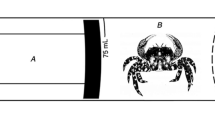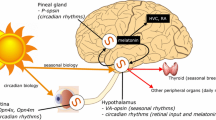Summary
The effects of raising cockroaches,Leucophaea maderae, in non-24-h light cycles on the response of the circadian system to light was examined.
-
1.
Phase response curves (PRC) were measured for 6-h light pulses for animals raised in LD 11∶11 (T22), LD 12∶12 (T24), and LD 13∶13 (T26). The delay portion of the PRC was found to be significantly reduced in T22 animals (compared to T24 animals) while the advance portion of the PRC was reduced in T26 animals. Compared to T26 animals, phase shifts were more positive at every phase for animals raised in T22.
-
2.
When transferred from constant darkness (DD) to constant light (LL) the freerunning period lengthened significantly less for T22 animals than T24 animals, and in some casesΤ in LL was actually shorter thanΤ in DD in T22 animals. Animals raised in LL were inactive when exposed to LL as adults, and unlike T24 animals, were consistently reset to the beginning of the subjective night (near CT 12) when transferred to DD.
-
3.
Roaches raised in T22 would entrain to LD 6∶18, but a few animals exhibited periods of relative coordination indicating that the 24-h light cycle was near the limits of entrainment.
These results indicate that the circadian system's responsiveness to light, as well as its freerunning period (Barrett and Page 1989), is dependent on the lighting conditions to which the animals are exposed during development.
Similar content being viewed by others
References
Barrett RK, Page TL (1989) Effects of light on circadian pacemaker development. I. The freerunning period. J Comp Physiol A 165:41–49
Daan S, Pittendrigh CS (1976) A functional analysis of circadian pacemakers in nocturnal rodents. III. Heavy water and constant light: Homeostasis of frequency? J Comp Physiol 106:267–290
Page TL (1982) Transplantation of the cockroach circadian pacemaker. Science 216:73–75
Page TL (1983) Effects of optic tract regeneration on internal coupling in the circadian system of the cockroach. J Comp Physiol 153:353–363
Page TL (1984) Neuronal organization of a circadian clock in the cockroachLeucophaea maderae. In: Photoperiodic regulation of insect and molluscan hormones. Ciba Foundation Symp 104. Pitman, London, pp 115–131
Page TL (1987) Serotonin phase-shifts the circadian rhythm of locomotor activity in the cockroach. J Biol Rhythms 2:23–34
Page TL, Block GD (1980) Circadian rhythmicity in cockroaches: effects of early postembryonic development and aging. Physiol Entomol 5:271–281
Pittendrigh CS, Daan S (1976) A functional analysis of circadian pacemakers in nocturnal rodents. IV. Entrainment: pacemaker as a clock. J Comp Physiol 106:291–331
Roberts S (1960) Circadian activity rhythms in cockroaches. I. The freerunning rhythm in steady state. J Cell Comp Physiol 55:99–110
Wiedenmann G (1977) Weak and strong phase shifting in the activity rhythm ofLeucophaea maderae (Blaberidae) after light pulses of high intensity. Z Naturforsch 320:464–465
Author information
Authors and Affiliations
Rights and permissions
About this article
Cite this article
Page, T.L., Barrett, R.K. Effects of light on circadian pacemaker development. J. Comp. Physiol. 165, 51–59 (1989). https://doi.org/10.1007/BF00613799
Accepted:
Issue Date:
DOI: https://doi.org/10.1007/BF00613799




